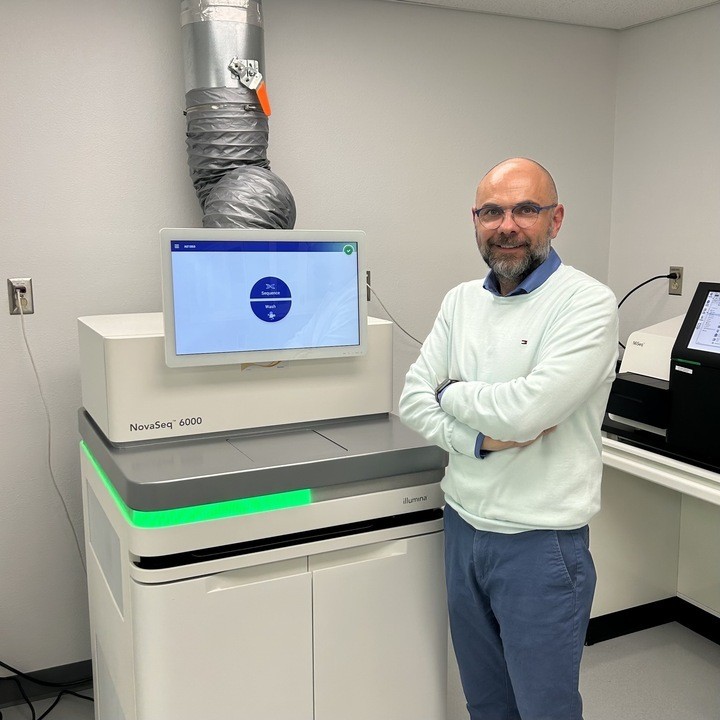The People Acting Now Discover Answers Core for Genomics and Microbiome Research at the University of Arizona Steele Children’s Research Center is using its new best-in-class genome sequencing machine to analyze genomes with more accuracy and speed than was previously possible.
The PANDA Core is an arm of the Steele Center that services the genetic sequencing needs of the pediatrics wing of Banner — University Medicine Center Tucson. There, the researchers focus on determining the exact sequence of A’s, T’s, C’s and G’s that make up the DNA in samples from patients’ microbiomes.
Analysis of this data can lead to insight into potential genetic defects, abnormalities in protein production and susceptibility to future conditions. The value of DNA data gathering and analysis is only in its beginning stages and continues to grow with the fields of genetics and genomics.
Daniel Laubitz, Ph.D., is the director of the PANDA Core at the Steele Center, where researchers possess two important machines: the Illumina MiSeq and NovaSeq 6000. The former is the older of the two and has been powering their microbiome sequencing for the last several years.
“Basically, our core supports any research field in the department of pediatrics and any other department at the [UA] if they do any kind of sequencing,” Laubitz said.
The name ‘core’ indicates that these scientists at the Steele Center work heavily with other research groups, not only doing sequencing for their own purposes but also operating as a service for other universities and institutions as well.
The NovaSeq 6000 will allow the PANDA Core team to perform tests for far less money and faster than ever before. With a capacity of “48 genomes in 40 hours,” according to Laubitz, this machine outperforms the UA’s last most powerful machine, the NextSeq, by a factor of 15.
The UA is currently the only academic institution in the state that has a machine of this capacity.
The microbiome research core is funded by People Acting Now Discover Answers, a women’s board dedicated to discoveries for improvement of treatments and cures for childhood diseases.
This funding group is the reason that the center was able to obtain such a sophisticated machine. At $1.3 million, the performance comes at a steep cost. However, the investment is worth it when put into the context of the new avenues to treatment options for patients in Arizona.
“Right now, if they really need to do whole genome sequencing, samples are sent to California or Colorado, somewhere out of state,” Laubitz said. With this new machine, diagnoses will be much faster.
Laubitz shared his view of how the new technology could allow researchers to change the way children with diseases are treated. Currently, there are many tests that have to be performed over weeks or months, which can result in the patient being in the hospital for a lot of time and spending a lot of money.
“Having this, we just take a little bit of blood and sequence the DNA,” Laubitz said. This demonstrates the improvement in outcomes that could be possible with the new machine: shortened stays in hospitals and reduced overall costs.
As director of the lab, Laubitz is overseeing its transition to Clinical Laboratory Improvement Amendments certification. This is a federal standard that governs all facilities performing tests on human samples that provide information for diagnosis, prevention or treatment of diseases. Once this is met, the PANDA Core will be able to use the NovaSeq to provide vital genetic information for diagnosis and treatment of many childhood diseases.
Laubitz emphasized the importance of working closely with doctors familiar with genetics and genomics.
“We work with Dr. Katri Typpo; she analyzes microbiomes in kids,” Laubitz said.
The close collaboration between research and patient contact care allows for quick decision making and more rapid response to a dynamic disease condition.
After acquiring the NovaSeq 6000, the PANDA Core at the UA’s Steele Children’s Research Center is preparing to implement changes to the way that they can provide solutions for patients and their healthcare team. With rapid full-genome sequencing capabilities, the options for children afflicted with these diseases can be vastly expanded and lead to better outcomes for more families.
Follow the Daily Wildcat on Twitter









